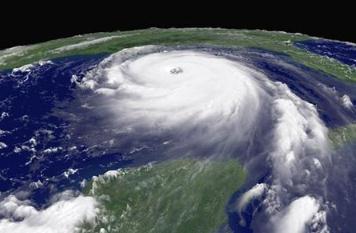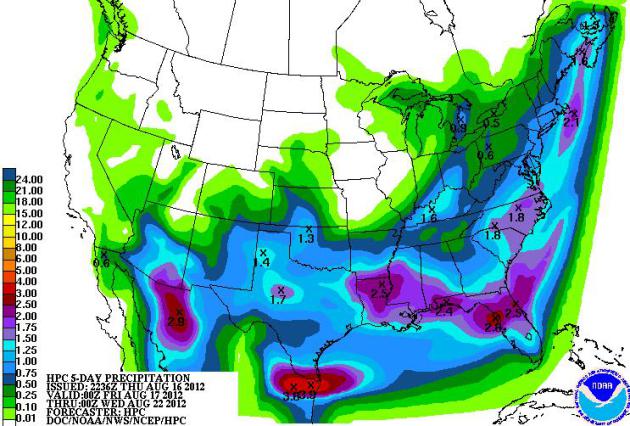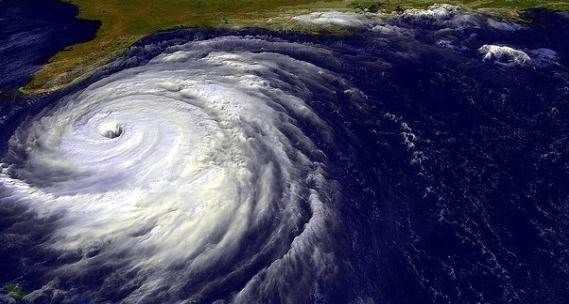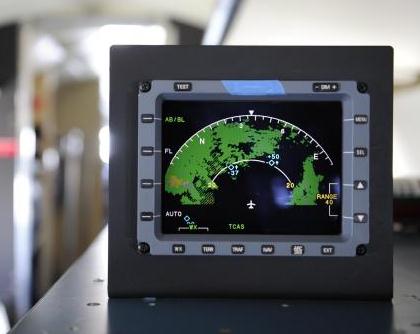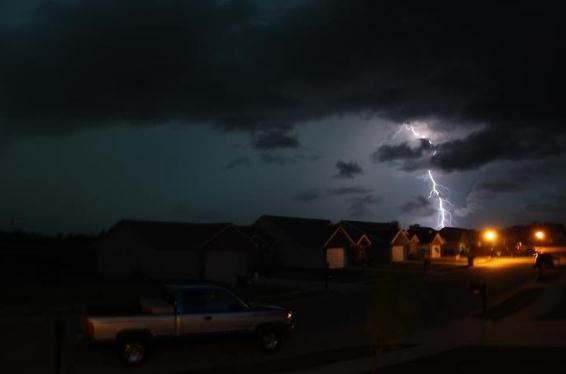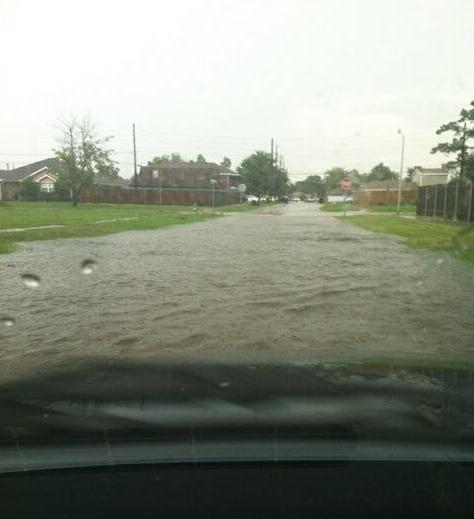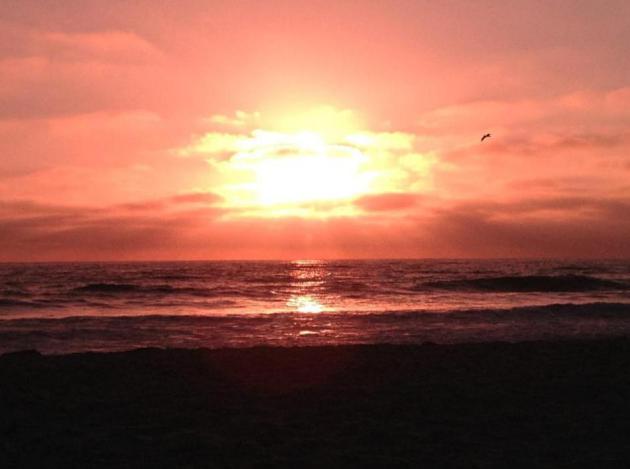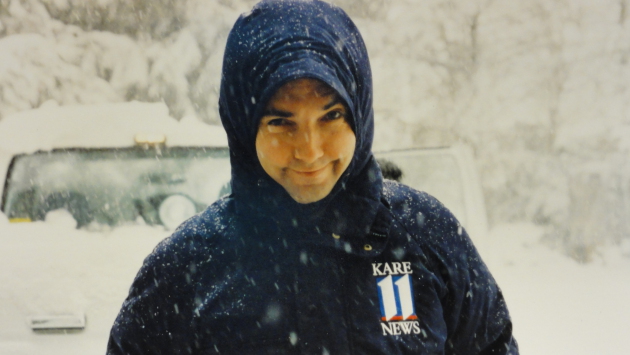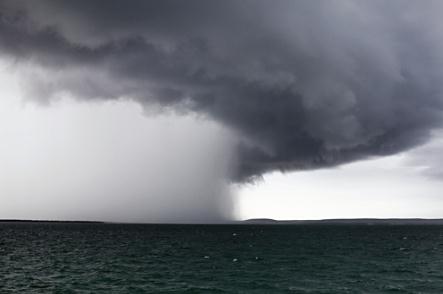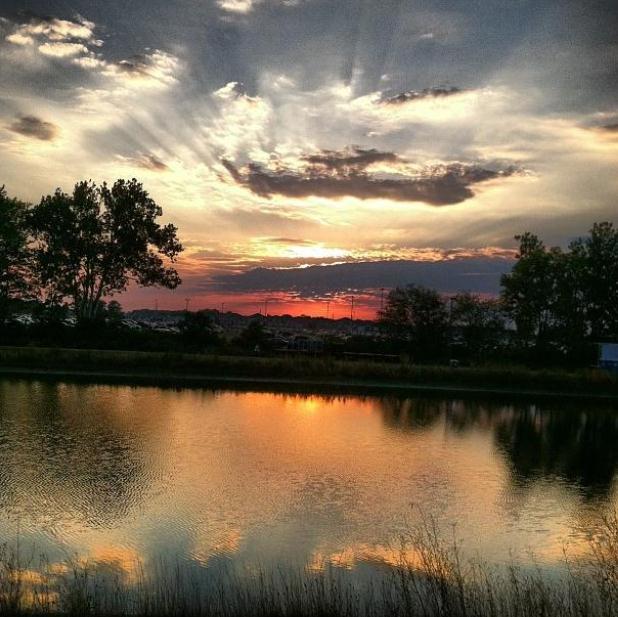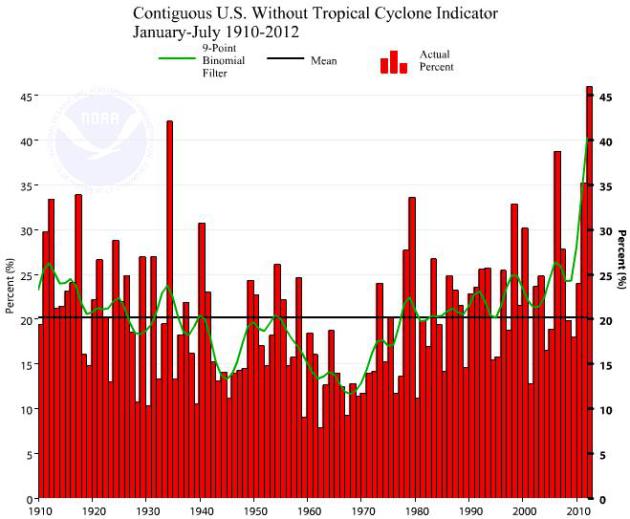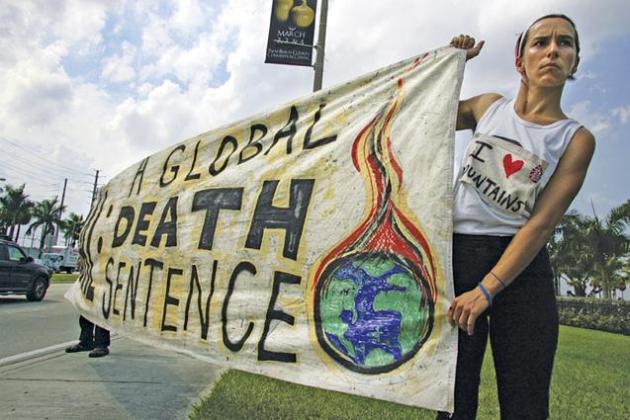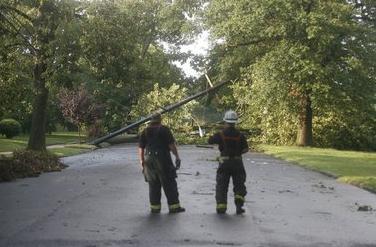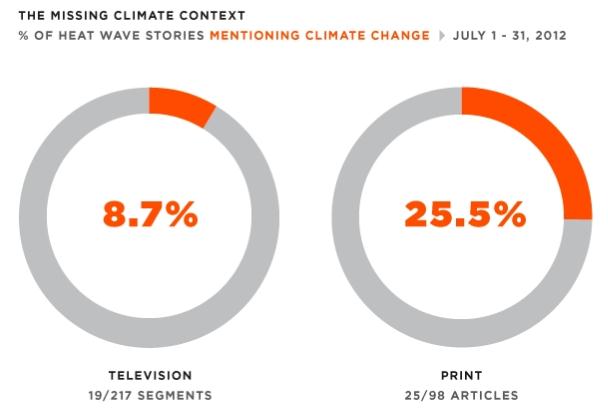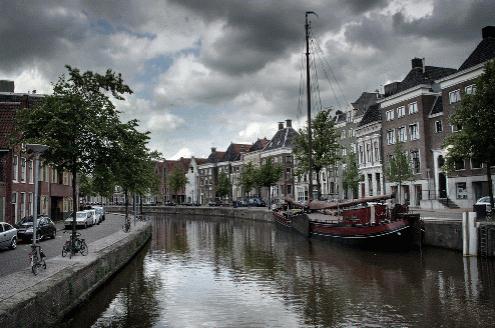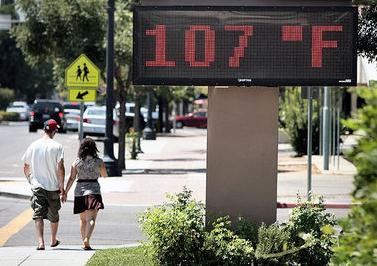141,412 cloud to ground lightning strikes yesterday as of 9:48 pm. Details from Vaisala below.
Latest Drought Monitor. The drought is holding
pretty much steady across the state (not increasing in coverage or
intensity). Although soil moisture is in good shape from the Twin Cities
to St. Cloud, Brainerd and Duluth, far southern, southwestern and
northwestern Minnesota is in moderate to severe drought. In fact a
little more than a third of the state is in a moderate drought, or
worse. The latest Drought Monitor is
here.
August 15 marks the start of what is, historically, the most active 30-day period for hurricane activity in the Atlantic and Caribbean.
$ 15.97 trillion dollars: America's debt.
$ 15.3 trillion dollars: 2012 GDP (Gross Domestic Product). Source: Bloomberg. Photo: AP,
Business Insider.
Weather Gone Wild. Here's an excerpt of an excellent cover story in this month's
National Geographic Magazine: "...
There’s
been a change in the weather. Extreme events like the Nashville
flood—described by officials as a once-in-a-millennium occurrence—are
happening more frequently than they used to. A month before Nashville,
torrential downpours dumped 11 inches of rain on Rio de Janeiro in 24
hours, triggering mud slides that buried hundreds. About three months
after Nashville, record rains in Pakistan caused flooding that affected
more than 20 million people. In late 2011 floods in Thailand submerged
hundreds of factories near Bangkok, creating a worldwide shortage of
computer hard drives. And it’s not just heavy rains that are making
headlines. During the past decade we’ve also seen severe droughts in
places like Texas, Australia, and Russia, as well as in East Africa,
where tens of thousands have taken refuge in camps. Deadly heat waves
have hit Europe, and record numbers of tornadoes have ripped across the
United States. Losses from such events helped push the cost of weather
disasters in 2011 to an estimated $150 billion worldwide, a roughly 25
percent jump from the previous year. In the U.S. last year a record 14
events caused a billion dollars or more of damage each, far exceeding
the previous record of nine such disasters in 2008."
Photo credit above: "
Supercell thunderstorm near Glasgow, Montana." Photograph by Sean R. Heavey, Barcroft Media/Landov.
Friday Severe Risk. The latest push (more like a
shove) of cool, Canadian air sparks more severe storms today from
Huntsville to Chattanooga to Lynchburg. Map above: SPC.
Today's Weather Map. The WRF model, valid at 4 pm
today, shows a band of strong to severe storms stretching from West
Virginia to the parishes of northern Louisiana. A bubble of cool,
Canadian high pressure treats the Midwest, Great Lakes and Ohio Valley
to comfortable sunshine, while the west continues to sizzle under a
blazing sun.
Expansive Puddles. NOAA HPC is predicting some 2-4"
rainfall amounts across much of the Deep South, the heaviest rains over
the next 5 days forecast from Louisiana to Biloxi into central Florida. A
dry sky lingers from the Midwest into the Pacific Northwest.
Lightning Explorer. Over 141,000 lightning strikes
yesterday as of 9:48 pm (when I was posting this?) Good grief. Looking
for lightning data, preferably for free? You may not be able to do
better than Lightning Explorer, from
Vaisala.
One word of caution: data is delayed by 20 minutes. This is NOT
real-time lightning information (which comes with a charge from any
weather company, including my own, Ham Weather). But using Explorer you
can see if lightning is nearby, and see the direction of motion of
T-storm cells (the most recent strikes show up as white on the map). A
useful tool.
Preparing Your Home For A Hurricane. Here's a very timely story from
The Washington Post; an excerpt: "...
First,
Kahn recommends buying C and D batteries. They were the first things
to fly off the shelves during the derecho, he said. Then, stock up on
flashlights, A-cell batteries, toiletries, fans and emergency cooking
supplies such as grills or hot plates that work on propane. “As soon as
something like this is projected to hit, the battery-operated stuff
gets wiped out immediately the same way bread disappears when a
blizzard is coming,” he said. “So it’s in your best interests to skip
that step and keep a small reserve handy.” When it comes to prepping
your home for a hurricane, the two biggest threats are roof damage and
flooding. Claude McGavy, the executive director of the National Association of Home Inspectors, said both are severely underestimated."
Photo credit above:
Pablo Martinez Monsivais/AP - "
The Martin Luther King Memorial is seen the morning after Hurricane Irene moved through the East Coast in 2011."
Study: Freshwater Helps Hurricanes Strengthen Faster. I had no idea - more breaking research on the hurricane front; here's an excerpt from
The Petri Dish: "...
Hurricanes feed off of fresh water, according to a report
from the Pacific Northwest National Laboratory. Researchers at the
PNNL, Texas A&M University and the Ocean University of China
examined ten years worth of data from tropical cyclones and found that
when hurricanes move over ocean regions ripe with fresh water, they can
quickly intensify. While researchers believe that the probability of
hurricanes moving over fresh water is only 10 to 23 percent, the impact
of the occurrence is quite dramatic. In fact, researchers think that a
hurricane under such conditions can become 50 percent more intense.
The findings are reported in a study that will be published this week
in the Proceedings of the National Academy of Sciences Early Edition."
Aircraft Radar Shows Pilots Airspace In 3-D. A local
firm, Honeywell, is getting some well-deserved attention over a new way
to visualize weather, up in the air. I hope my next Delta flight has
this innovation (especially when I'm bumping my way across the Rockies).
USA Today has the story; here's an excerpt: "...
For
the first time, the new radar, now being installed in business,
military and commercial aircraft, allows pilots to "see" turbulence
and other bad weather such as lightning and hail from nearly 70 miles
away. The radar, manufactured by Honeywell, "looks at the airspace in
front of the aircraft in three dimensions, which is an improvement over
existing radars," says Honeywell senior chief engineer Ratan Khatwa.
Current radars used by pilots now take only a two-dimensional slice of
the atmosphere, the width and length, for instance, of storms crossing
an area. "It provides information to the flight crew where the real
weather hazards such as lightning and hail are which is not available
today," he says."
Photo credit above: By H. Darr Beiser, USA TODAY. "
Honeywell's on-board aircraft radar gives pilots a better picture of storms and inclement weather in their path."
Enlightening. Thanks to Mulvaney Shane, who snapped this electrifying photo near Charlestown, Indiana on Thursday.
Flash Flood. Persistent thunderstorms sparked
significant flooding across the New Orleans area; this photo courtesy of
the local National Weather Service.
Hail And High Water. Thanks to Richard Pacheco, who drove through a severe hailstorm in New Mexico Thursday. On
Twitter he wrote: "
So much hail thought it was snow!!"
Seattle Heat. One of our (amazing) developers,
Nicholas Shipes, sent in this photo from Seattle yesterday, where
temperatures were approaching 90 F. Keep in mind few people in the
Northwest have A/C. The vast majority of the year they don't need it.
Pic courtesy of
Twitter.
One Unusual Cloud. Ensign Brett Kruhoeffer, based in
Pensacola (where he's training to fly helicopters for the Navy) shared
this strange-looking cloud on Tuesday. What the heck is that thing? Wait
a minute....
Tranquility Base. Thanks to Leslie Berg, who captured the serenity of a Mission Beach, California sunset.
"Ask Paul". Weather-related Q&A:
Paul,
Our trip out west to Yellowstone and Grand Tetons was super. I
experienced "dry lightning" and saw an actual wall cloud on the way out
there. The wall cloud held together only about 10-15 minutes, but had a
decent thunderstorm with it. You know that smell you have when rain is
darn near your doorstep or during the first few minutes of a shower,
usually most noticeable during sprinkles?
Well, when we actually did encounter rain out west, there wasn't an
odor with the rain.The one band of T-storms we saw on the way out had
what I call a rain-cooled fresh smell. Was in the low 90s with a breeze
from the south but the storm we had saw winds change from the north, and
when the rain came though, temperatures fell 25 degrees. The rain
events that didn't smell were east of Rapid City, and once in Jackson
Hole, Wyoming.
Any reason why the rain out there didn't smell?
Thanks.
Aaron Coates
Hennepin County Sheriff's 911
Golden Valley
Aaron - there is considerable debate about the source of this smell
(usually found before a rainfall). The best answer I could find was from
thenakedscientists.com (great name for a web site, huh?). Paul writes: "
the
smell after rain is actually the smell of bacteria - actinomycetes.
They grow worldwide in damp soil. When the soil dries out, they die. But
before they die, the make spores. These spores are really tough and can
survive dry conditions for years. When raindrops hit the ground they
make a mist of water and dirt, which you both breathe in and smell."
Why didn't you smell this in South Dakota or Wyoming? It may be a
function of topsoil. Here in the Midwest we have rich, deep loamy
topsoil, the envy of the world in many respects. But the farther west
you go the thinner the topsoil becomes (and the fewer spores available
to mix with rain). That's the only thing I can think of offhand. Thanks
for a great question!
Reinvent The Toilet Fair In Seattle. No, you can't make this stuff up - but it's for a good cause, improving sanitation for billions of people.
Gizmag.com has the story; here's an excerpt: "
In
an effort to improve conditions for the more than 2.5 billion people
worldwide with no access to safe sanitation, the Bill & Melinda
Gates Foundation last year awarded grants totaling US$3 million to eight
universities to reinvent the toilet. At the two-day “Reinventing the
Toilet” fair held in Seattle this week, where Bill Gates was on hand
with 50 gallons (189 l) of fake feces made from soybeans and rice to put
the various designs through their paces, a California Institute of
Technology (Caltech) team claimed first place for their solar-powered
toilet."
The Science Of Cute. I found this
gizmag.com article interesting - how do our brains calculate "cute"? Here's an excerpt: "
Let’s
pretend that a mewling, pooping annoying small thing is deposited in
your lap. It needs constant input from you. Before long, it’s taken
over your life. You find yourself lavishing attention on this new
creature. Going out is a distant memory. But the thing is, the new baby
is cute. Really cute. You can’t help but feel protective. You want to
look after it. But why? Why do small helpless things – babies, kittens,
puppies, pandas in baby form – turn even the most cynical human into a
helpless wreck? Why don’t we have the same reaction to a baby lizard or
fish or bird? What, in short, is this cuteness thing all about?"
* sunset photo above courtesy of Danny Kurily.
All or Nothing
"Only in Minnesota can you be ankle-deep in mud
with dust blowing in your face." Our manic weather has always
been..um..character-building. But now it seems we're either stuck in
severe drought, or cowering thru a 1-in-500 year flood. Duluth comes to
mind. Either a 95-degree barbecue - and we're the main course - or we're
reaching for light jackets. This morning comes to mind.
According to NOAA NCDC - 46 percent of America
has experienced extreme weather this year; a new record high. At this
rate I may never leave my basement.
Talk about a time warp. It feels like early
October, but jackets give way to a lukewarm afternoon; less wind and
fewer scrappy cumulus clouds than yesterday. A dry spell of weather
prevails into next week but models hint at a few instability showers
around the dinner hour Saturday and Sunday. Most of the weekend will be
dry and comfortable. Highs reach low 70s; dew points dip into the 40s. A
deep cleansing breath.
Don't even think of retiring shorts and
t-shirts. Heat builds north again next week. Although not nearly as hot
as July, I could see a few 85-90 degree highs the latter half of next
week.
A sweaty 90-degree state fair?
Imagine that.
Climate Stories...
Climate Science As Culture War. Here's an excerpt of a fascinating and (in my opinion) deeply troubling story from
Stanford Social Innovation Review: "...
Today,
there is no doubt that a scientific consensus exists on the issue of
climate change. Scientists have documented that anthropogenic sources of
greenhouse gases are leading to a buildup in the atmosphere, which
leads to a general warming of the global climate and an alteration in
the statistical distribution of localized weather patterns over long
periods of time. This assessment is endorsed by a large body of
scientific agencies—including every one of the national scientific
agencies of the G8 + 5 countries—and by the vast majority of
climatologists. The majority of research articles published in refereed
scientific journals also support this scientific assessment. Both the US
National Academy of Sciences and the American Association for the
Advancement of Science use the word “consensus” when describing the
state of climate science. And yet a social consensus on climate change
does not exist. Surveys show that the American public’s belief in the
science of climate change has mostly declined over the past five years,
with large percentages of the population remaining skeptical of the
science."
Photo credit above: "
South Florida Earth First members protest outside the Platts Coal Properties and Investment Conference in West Palm Beach." (Photo by Bruce R. Bennett/Zum Press/Newscom
Survey Finds 2 Percent Of Canadians Don't Believe Climate Change Is Happening. Details from The Canadian Press and
Yahoo: "
REGINA
- Only two per cent of Canadians who responded to a new opinion poll
believe climate change is not occurring. The findings are in a survey
conducted by Insightrix Research, Inc. for IPAC-CO2 Research Inc., a
Regina-based centre that studies carbon capture and storage. The online
poll of 1,550 people was done between May 29 and June 11. The results
were to be released on Wednesday. "Our survey indicates that Canadians
from coast to coast overwhelmingly believe climate change is real and
is occurring, at least in part due to human activity," said centre CEO
Carmen Dybwad."
Opinion: Severe Storms Prompted By Climate Change Require New Development Policies. Here's an excerpt of an Op-Ed an
NJ.com in New Jersey that caught my eye: "...
Increased
flooding also changes the aquatic ecological systems by changing
spawning cycles, increasing the amount of sedimentation in streams and
rivers (thereby reducing available oxygen and blanketing stream beds
with sediment), and increasing the harmful impacts of runoff of
fertilizers, pesticides and other pollutants, all resulting in loss of
aquatic life. Storms of greater intensity do more damage to trees and
other vegetation. They also over-saturate the soil, leading to weakened
roots. Too much water can kill vegetation as much as can too little
water. Soil saturation leads to basement flooding and unstable soil
conditions, which may result in more sinkholes and problems with
building foundations. There could also be impacts to septic systems
that rely on the soil to remove and dispose of pollutants. Homes,
buildings and roadways built near the coast, in flood plains or on
poorly drained soils will most likely see an increase in problems due
to these storms. However, all of us are likely to face additional
complications from this trend..."
Photo credit above:
Christina Izzo/The Times of Trenton "Two
Trenton firefighters look at the damage a tree caused during a
thunderstorm. The tree (on Cadwalader Drive) fell on some wires,
causing the pole to fall down."
Talk Climate Change Solutions, Win Votes: Yale Study. Here's an excerpt of an intriguing story from
treehugger.com: "
Conventional
beltway wisdom holds that if you're running for office, you don't
touch climate with a ten foot pole. It's considered "politically
toxic," albeit by a cohort that tolerates birtherism and Donald Trump
participating in the political process. So unless you're gunning to
represent one of those wacky radical leftist states like Vermont or
California or Massachusetts, any meaningful engagement on climate
issues is off the table. The politicos say so. Obama took the hint; he
almost never mentions global warming in public. Romney's mum, too. But new Yale research
(pdf) says that conventional wisdom is probably wrong. A new study
from the Yale Project on Climate Change Communication finds that there
are indeed a group of climate issues voters who will be more likely to
support a candidate who's pro-climate."
Photo credit above:
Wikimedia Commons/CC BY 2.0
Study: TV Media Ignore Climate Change In Coverage Of Record July Heat Wave. Here's an excerpt from
Media Matters: "
Scientists
say that human-induced climate change made this year's record heat
more likely, and project that extreme heat will become more common in
the United States. But a Media Matters analysis of media coverage of
record-breaking heat in July finds that major television outlets rarely
made the connection between heat waves and a changing climate. Only 14% Of Heat Wave Stories Mentioned Climate Change. In
a study of major media outlets, only 8.7% of television segments and
25.5% of print articles reported on record-breaking July heat waves in
the context of climate change."
Urban Heat Island Effect And Climate Change May Cause Scorching Summer Temperatures.
It's a potential double-whammy: excess heat radiating up from concrete
and asphalt, coupled with warming background temperatures. Here's an
excerpt of a story from Climate Central and
Huffington Post: "
For
scientists who worry about climate change, cities are just plain
annoying. The acres of asphalt that cover roads and parking lots and
roofs absorb enormous amounts of heat. In the summer, whirring air
conditioners channel even more heat out of buildings and into the air. Climate scientists have to subtract this so-called urban heat island effect
from their calculations if they want to get a true picture of how
greenhouse gas emissions are warming the planet. For people who actually
live in cities, however the urban heat island effect is more than just
a mathematical annoyance. If you’re sweltering on a hot summer day,
your body doesn’t much care where the heat is coming from. And
according to a paper just published in Nature Climate Change,
urbanization alone could drive local temperatures up by a whopping 7°F
by 2050 in some parts of the U.S. — some two or three times higher
than the effects of global warming (which would also be going on at the
same time)."
Leading By Example: The Dutch Prepare For Climate Change. Here's an excerpt of an interesting article at
opednews.com: "...
The
Netherlands is a country particularly vulnerable to rising sea levels,
as two-thirds of its population lives below sea level. Throughout its
history, the Dutch have understood the inevitability of change and how
society must work with nature for effective strategies. In 2007, the
Dutch began preparing for the changing climate in the upcoming two
hundred years. They recognize that their nation will continue to combat
rising seas, and must act expeditiously in order to prevent further
encroachment. In State of the World 2012,
Erik Assadourian outlines the 200-year plan put forth by the Dutch,
describing their strategy to spend $1 billion a year on climate change
adaptation. Through such policies, it is clear that the Netherlands is
focused on the long-term public interest and not short-term private
interests. The Dutch plan
combines innovative techniques like building surge barriers and
extending the coastline, with more traditional methods, such as
fortifying levees."
Photo credit above: "
Old Dutch canal." (Photo via Flickr, by Joepydo)
Methane From Fracking Triggers Climate Change. From
what I understand about hydro-fracking, an important (and in my humble
opinion - vital) energy source for America going forward, with far less
greenhouse gas emissions than coal or oil, it would cost an additional
7% for operators to clean up fracking operations, so they won't pollute
groundwater supplies or leak methane from drilling sites. There is a lot
of concern about the environmental impacts of "fracking". Here's an
excerpt of an Op-Ed at
syracuse.com: "
Far
from being a climate solution, fracking may be a disaster for our
climate. Research indicates the methane leakage may mean that fracking
is worse for the climate than coal and oil, particularly in the short
term. Gas from fracking is mostly methane, a dangerous greenhouse gas
that is up to 105 times more powerful at trapping heat in the
atmosphere than carbon dioxide over 20 years. A recent United Nations
Environment Program report shows that it is more urgent to reduce
methane than CO2, given that methane is so much more powerful, has
quicker climate impacts and will trigger runaway climate change sooner.
According to the Nobel-prize-winning Intergovernmental Panel on
Climate Change, we must immediately reduce our greenhouse gas emissions
to avoid dangerous tipping points for the climate. Failing to do so
will cause catastrophic impacts, far worse than the extreme heat and
droughts this summer."
Photo credit above:
AP Photo/The Fresno Bee, Craig Kohlruss. "A
sign on a building Friday reads 107 degrees in Clovis, Calif. A recent
United Nations Environment Program report shows the need to reduce
methane, which is released by fracking, since the gas traps heat in the
atmosphere."

